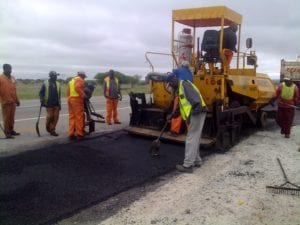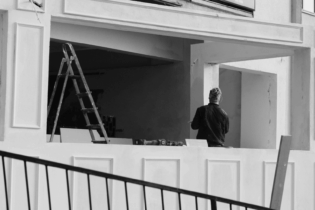The aim of the upgrading of arterial roads in Mankweng Cluster – situated 21 km north of Polokwane city – was to increase mobility through the existing villages while, at the same time, providing a transport link between two provincial roads. IMIESA takes a look at this project.
Commissioned by Polokwane municipality, the upgrading of arterial roads in Makweng Cluster (Makotopong to Ga-Mojapelo) consists of upgrading from gravel to local distributor tar-surfaced standards for a distance of approximately 16 km and includes storm water drainage systems. Phase 1 (3.1 km of the road) was constructed in 2009 and phase 2 (3.5 km) is currently underway. The Municipal Infrastructure Grant application for the remaining 9.4 km was completed in 2011 and submitted for approval. At the time of going to press, it was indicated that there should not be any problems with the approval and the consultant anticipated that designing the remaining phase 3 (9.4 km) will start in February 2012, with construction commencing in June 2012. Scope of works: Phase 1The budget for phase 1 was estimated at R12 799 236.88 (all incl.) and included:
• site establishment
• clearing and grubbing
• upgrading from gravel to tar at local access distributor surfaced standards of approximately 3.1 km of road
• construction of storm water drainage structures
• construction of a SANRAL intersection (R81 – Duiwelskloof Road)
• construction of a railway level crossing (constructed by Transnet)
• construction of bus bays. The earthworks activities of cut to spoil and borrow to fill were done up to the road bed level on the 3.1 km road and main road intersection. The storm water system for the road consisted of the following:
•An underground 450 mm diameter storm water pipe system, which ended with a rock-fill sausage drain constructed with bidim at the outlet of the system.
•Cross drainage, with 600 mm diameter storm water culverts, was constructed along the road.
•Construction of the storm water structures (grid inlet, kerb inlets and culvert head and wing-walls).
•Stone pitching was done at kerb outlet chutes and around all the culvert head and wing-walls.
•The entrances of the culverts were trimmed and shaped, and the culvert exits were day-lighted to drain.
•Open V-drains were also constructed and shaped to drain according to specified culverts. The 3.1 km road, which includes bell-mouths and bus bays, was surfaced with a 13.2 mm/6.7 mm double seal with an S-EI modified binder. The main road intersection was initially to be surfaced with a 19 mm cape seal but this was replaced with a 30 mm continuously graded asphalt seal.
The railway level crossing was constructed by the contractor, in conjunction with Transnet, using pre-cast concrete blocks. The 3.1 km road was constructed to tie in with the railway crossing and safety inductions where conducted by Transnet on site before work commenced, with supervision being given throughout the construction period of the level crossing.
Road signs were erected along the road, with road direction and speed limit signs being erected at the main road intersection. Provision has been made for the road markings to be re-painted at the end of the maintenance period. Phases 2 and 3The budget for phase 2 is estimated at R11 300 000 (all incl.) and included:
•site establishment
•clearing and grubbing
•upgrading from gravel to tar at local access distributor surfaced standards of approximately 3.5 km of road (to start where phase 1 ended)
•excavation and backfilling of pre-fabricated pipe culverts
•construction of storm water drainage (culverts, piping, drains and kerbs)
•construction of bus bays
•construction of bell mouths. Phase 3 is estimated to cost R41 690 626 (all incl.) and included:
•site establishment
•clearing and grubbing
•excavation and backfilling of pre-fabricated pipe culverts
•construction of storm water drainage (culverts, piping, drains and kerbs)
•upgrading from gravel to tar at local access distributor surfaced standards of approximately 9.4 km of road (to start where phase 2 ended)
•construction of bus bays
•construction of bell mouths
•construction of intersection
•site cleaning. The completed road will be able to handle approximately 250 average annual daily traffic and the estimated number of people who will benefit is 20 768. Once construction of phase 3 is complete, the project will have upgraded 16 km of road to tar-surfaced standards including storm water drainage systems, bus bays, bell-mouths and intersections. The total project cost including all three phases, will be approximately R66 million.
PROJECT TEAM
Consultant Nyeleti Consulting Engineers
Contractor: Phase 1 Patrick Makgoka Construction cc
Contractor: Phase 2 David Diva Construction/Limpopo R&R Joint Venture








